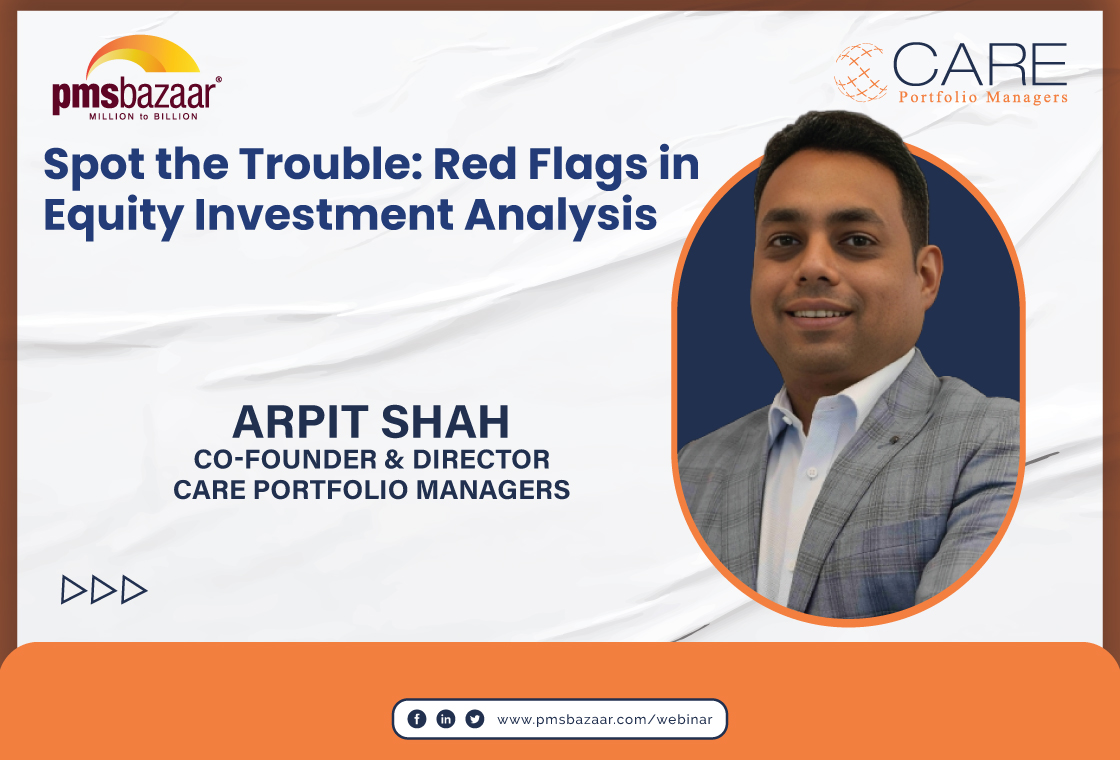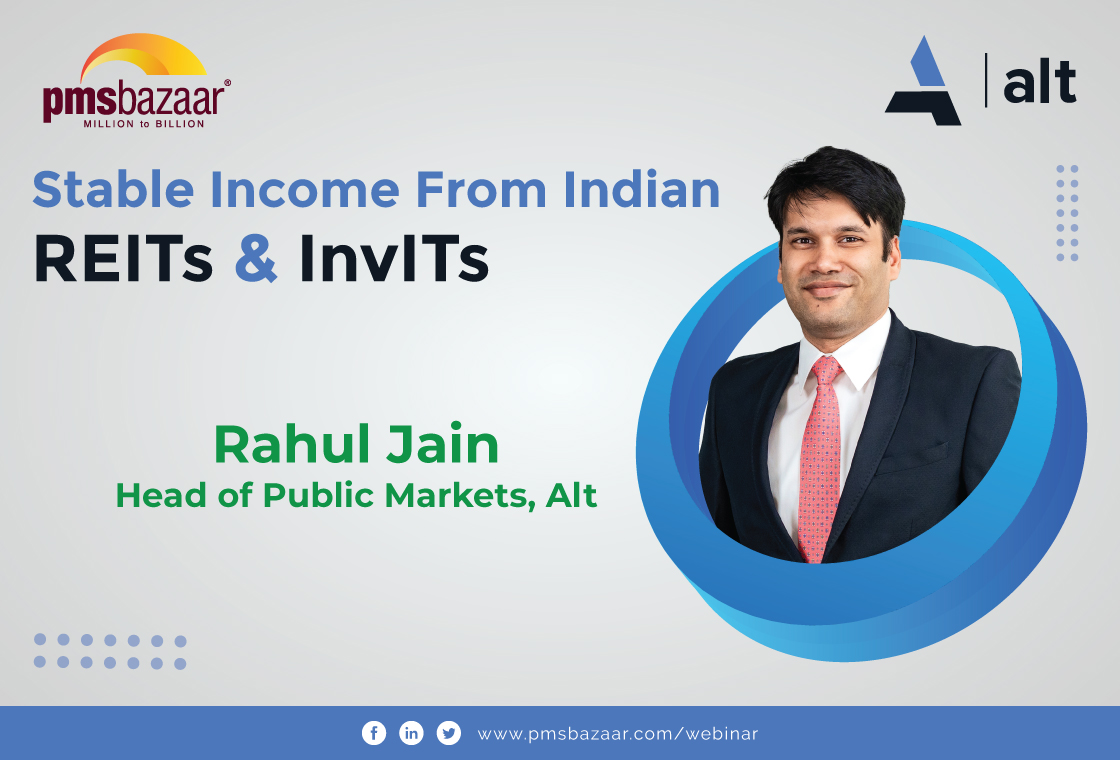After lying low for quite sometime, midcaps are back with a bang. In just the last 3 months, the S&P BSE Midcap index is up 20%, out-performing even the Sensex. But, midcap investing is not about 3 months or 12 months. One needs to give due time to midcaps to flourish. If one can give 5 years, there is a 50% chance that a midcap company can emerge into a largecap corporation, and grow your wealth in a big way, says Rakesh Tarway, Portfolio Manager, Motilal Oswal AMC in an exclusive PMS Bazaar webinar. In an insightful session spread over one hour, Tarway, who has 17 years of experience in equity markets as analyst and head of research, shares investing lessons about midcaps and discusses the Motilal Oswal Focused Midcap PMS strategy. Read on to know more.

When wealth creation happens
The amount of time you invest into your products determines the quality of the products. Similarly, when you invest more time into something than others, you become the best among equals. This is true for midcap investing. According to research done by Motilal Oswal, a time period of 5 years is required to see robust wealth creation.
"In any 5 year period, maximum wealth is created when a smallcap becomes a midcap and a midcap becomes a largecap company. If one invests in midcaps, the probability that a midcap will remain or become a largecap in 5 years and reward investors is as high as 50%. In any 5 year cycle when this plays out, there are 2-3 terrible years and 2-3 great years. 2000-03 was bad followed by 2004-05, 2005-07 were great, again followed by 2008-09, 2010-13 were terrible, followed by 2014-15 that was good," Tarway says.
He cautions that investing depends on taking chances. There will always be one or two calls that go wrong, that is why one must look at the overall portfolio or bouquet held, Tarway added.
Ups and downs will happen
Since 2018, midcaps haven't had a great run. Nifty 50 has in fact outperformed Midcap/Smallcap indices by 27/42% respectively between December 2017 to July 2020.
"After making a high in January 2018, midcaps and smallcaps suffered. Even the recovery that has happened from April onwards in 2020, for those who invested in peak have not made money in midcaps. If somebody had put Rs 100 in Nifty in January 2018, even after the fall they are sitting on Rs 106. In case of midcaps, the same Rs 100 is now Rs 73. In smallcaps, Rs 100 has become Rs 55. Last two years have been a very top-heavy market," says Tarway.
But, there is light at the end of the tunnel. Research shows that historically midcap and smallcap indices have massively outperformed the Nifty after bad periods.
"Correction or underperformance gives a better entry point. Reversion to mean will happen. Take the example of the coming back of midcap and smallcap space from April. Note that the reversion to mean is not complete," says Tarway, adding that the process will only be near completion once midcap and smallcap indices start making new highs. For example, the smallcap index high is 25% away from its peak. Midcap index is also at similar levels. But Nifty is just shy of its all-time high.
Why midcaps now
As highlighted earlier, midcaps and smallcaps tend to perform in extremes and revive sharply after bouts of negative returns. "Calendar year 2018, 2019 and 2020 are only 3 consecutive years in 15 years history to have returns in negative in midcap and smallcaps," pointed out Tarway.
In this kind of set-up, investors must always remember that bottom-up stock picking is very crucial. "The wide dispersion of returns in both mid as well as smallcap provide a scope for bottom-up stock picking. Our portfolio stance is very clear. There is a healthy mix of smallcap, midcap and largecap with 15-25% weight in largecaps. As far as possible, we are maintaining positions in unlevered companies i.e. those with Debt to Equity ratio of less than 0.5 including lending businesses. The growth outlook at portfolio level is 20% plus for FY20 to FY23. Portfolio level RoE is 15% plus," says Tarway.
Motilal Oswal PMS is sector agnostic, but it generally tries to avoid pure-play commodities and cyclicals. "Our focus is on being in unique stocks. These are where there is not much institutional ownership," says Tarway, adding that Motilal Oswal Focused Midcap PMS strategy has stocks like Muthoot, Dixon, Amber, Aster and Mastek among others.
Talking about portfolio discipline, the fund manager shed light on allocation as a function of convictions, "It is not dependent on price per se. We maintain active targets of profits and prices on stocks with 1, 2 and 3 year view. Mismatch of price and timelines should lead to action on folio on both sides i.e. buying and selling. We regularly trim positions if targets are reached ahead of time. Similarly, there is regular addition of positions if profits are inline or ahead of times and stock price is not responding," Tarway revealed.
Motilal Oswal Focused Midcap PMS strategy has delivered absolute returns of 11.7% vs Nifty Mid-Smallcap 400 TRI return of minus 6% since inception in December 2019.
Those who missed the opportunity to hear from the Experts directly can listen to the entire session through the appended link:
For more information, please contact info@pmsbazaar.com
Recent Blogs
.jpg)
Passively Active Investing — A Modern Investor’s Lens on ETF-Based PMS
PMS Bazaar recently organized a webinar titled “Passively Active Investing — A Modern Investor’s Lens on ETF-Based PMS,” which featured Mr. Karan Bhatia, Co-Founder and Co-Fund Manager , Pricebridge Honeycomb ETF PMs. This blog covers the important points shared in this insightful webinar.

Spot the Trouble: Red Flags in Equity Investment Analysis
PMS Bazaar recently organized a webinar titled “Spot the Trouble: Red Flags in Equity Investment Analysis,” which featured Mr. Arpit Shah, Co-Founder & Director, Care Portfolio Managers. This blog covers the important points shared in this insightful webinar.

Long-Only AIFs Rebound Sharply in October; Long-Short Strategies Lag Despite Lower Volatility
106 long-only AIFs averaged 3.68% vs 32 long-short AIFs at 2.7%; only 24–31% of funds beat key indices

Markets log strongest monthly gains in 7 months; PMS performance turns near-uniform in October
Nifty 50 TRI gained 4.62%, BSE 500 TRI rose 4.27%; 415 of 427 equity PMSes ended positive

How SMEs are Shaping India’s Investment Landscape?
PMS Bazaar recently organized a webinar titled “How SMEs are Shaping India’s Investment Landscape?” which featured Mr. Shrikant Goyal, Fund Manager, GetFive Opportunity Fund.

Stable Income from Indian REITs and InvITs
PMS Bazaar recently organized a webinar titled “Stable Income from Indian REITs and InvITs,” which featured Mr. Rahul Jain, Head of Public Markets, Alt.

5 Key Considerations Before Investing in AIFs in India
Alternative Investment Funds (AIFs) have emerged as a compelling option for sophisticated investors seeking diversification and potentially superior returns. But venturing into AIFs requires a clear understanding of their unique characteristics that go beyond simply knowing what they are and their categories.

How AIF can help in diversification?
Traditionally, Indian investors have relied on a mix of stocks and bonds to build their wealth. While this approach offers diversification, it can still leave your portfolio vulnerable to market fluctuations. Enter Alternative Investment Funds (AIFs), a dynamic asset class gaining traction for its ability to unlock diversification beyond the realm of conventional options.

